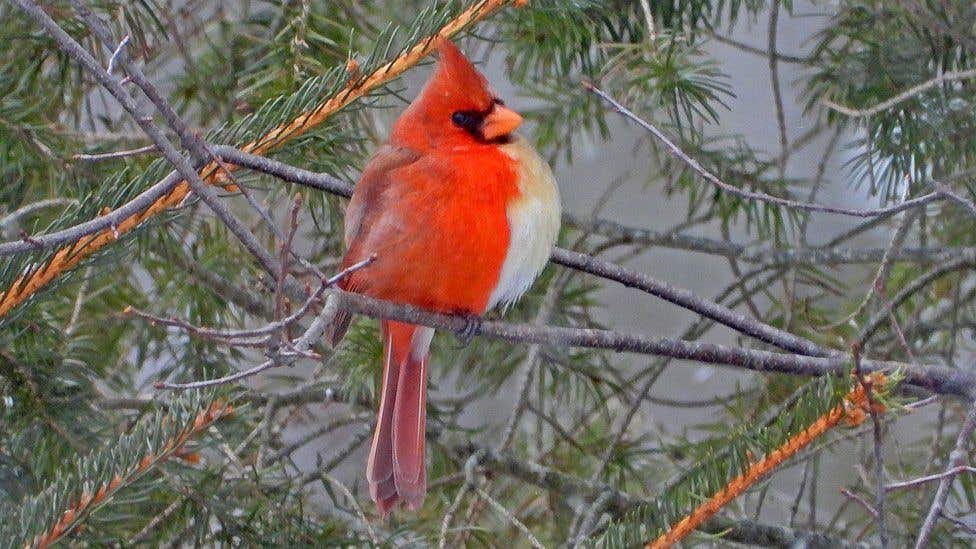Once-in-a-lifetime find: Rare half male, half female cardinal spotted in Pennsylvania
A bird watcher in Pennsylvania spotted what he called a once-in-a-lifetime bird encounter — a cardinal with two colors that is half male…

[Feb. 24, 2021: Jamie Hill]
A bird watcher in Pennsylvania spotted what he called a once-in-a-lifetime bird encounter — a cardinal with two colors that is half male and half female.
James Hill said he spotted a rare bilateral gynandromorph Northern Cardinal on Saturday. He said the bird could in theory mate with a male bird and lay eggs or mate with a female and father the eggs.
Hill heard about the bird from a friend of the homeowner where the bird was spotted. He got the homeowner’s permission to snap pictures of the unique bird.
Hill gave more information about the rare cardinal on his Facebook page.
"I have been birding for 48 years and yesterday (20 February 2021) I had a once-in-a-lifetime, one in a million bird encounter! Annette Smith and I were able to see, and I was able to photograph, this extremely rare, bilateral gynandromorph Northern Cardinal (Cardinalis cardinalis)."
"Here is the back story: Annette’s mother told us that a friend of hers had an unusual bird coming to her bird feeders near Grand Valley, PA, in Warren County, “that was ½ one species and 1/2 another.” This really piqued my interest since I wasn’t sure if she was referring to a hybrid, or a much rarer gynandromorphic bird (a bird that is ½ male and ½ female). We immediately tracked down the homeowner by phone and were told it was a male Northern Cardinal that “had some white on its breast.” Ah, I thought maybe it was leucistic, which means it has some albinistic feathering. We asked her if she had taken a photo of it and she said yes. She texted us a cell phone photo of it taken through a window and it was immediately apparent that this was no leucistic bird, it was indeed a cardinal with extremely rare bilateral gynandromorphism, which means it is genetically half male and half female! This bird would have a functioning ovary on its left side and a functioning single testis on its right. Theoretically, this bird could either mate with a normal male cardinal and lay fertile eggs, or it could mate with a normal female cardinal and father her eggs!"
"We asked the homeowner if we could come try to document this rare bird with my photography equipment, and she obliged. The results are shown here. During our 1-hour stay, the bird came to the feeders only once (with 5 other cardinals), but thankfully it perched out in the open briefly in two other trees and I was able to shoot about 50 images. Here are the best ones I could capture in a one-hour stay."
"In 2019, a couple living 60 miles away in nearby Erie, PA, had a similar cardinal coming to their bird feeders and they got some photos of it, too. Their photos made it into the National Geographic Magazine, the New York Times, and many national birding magazines. That’s how rare and interesting this condition is. Could this bird be the same individual as the Erie, PA, bird? Possibly — their bird was female on the left and male on the right, too. The condition can be the other way around, with male left and female right."
"So, how does a bird become a bilateral gynandromorph? According to Dr. Daniel Hooper, who was a postdoctoral fellow at the Cornell Lab of Ornithology in 2019 and who was contacted by National Geographic for their article: ”sex determination in birds is a little different than in mammals. In mammals, males have one copy of each sex chromosome (X and Y) while females have two copies of the X chromosome. In birds, it’s the opposite. Their sex chromosomes are called Z and W, and it’s the females that have a single copy of each (ZW), whereas the males have two of the same (ZZ). Sex cells’ nuclei, including sperm and eggs, usually have only one copy of either chromosome — males produce only Z-carrying sperm, and females produce either Z- or W-carrying eggs. Gynandromorphy, like that in this cardinal, occurs when a female egg cell develops with two nuclei — one with a Z and one with a W — and it’s “double fertilized” by two Z-carrying sperm.”
"Dr. Hooper and National Geographic went on to say that “Gynandromorphs, known as “half-siders” among ornithologists, are uncommon, but not unheard of. They likely occur across all species of birds, but we’re only likely to notice them in species where the adult males and females look distinct from each other, a trait known as sexual dimorphism. Cardinals are one of the most well-known sexually dimorphic birds in North America — their bright red plumage in males is iconic [with females being buffy brownish] — so people easily notice when they look different.”
"The homeowners of this 2021 bilateral gynandromorph Northern Cardinal request anonymity and no visitors, however, the bird is residing in Warren County, PA, in the general area of Grand Valley, PA, as stated."
Like these kind of stories? Get The Brighter Side of News' newsletter.
Tags: #Good_News, #New_Discovery, #Birds, #The_Brighter_Side_of_News



